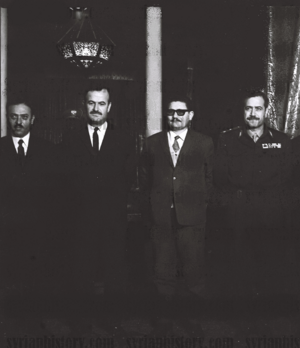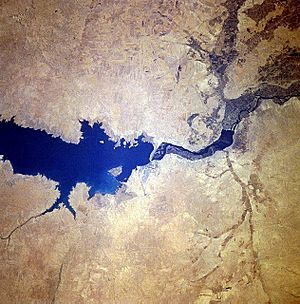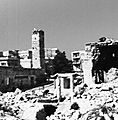Hafez al-Assad facts for kids
Quick facts for kids
Hafez al-Assad
|
|
|---|---|
|
حافظ الأسد
|
|
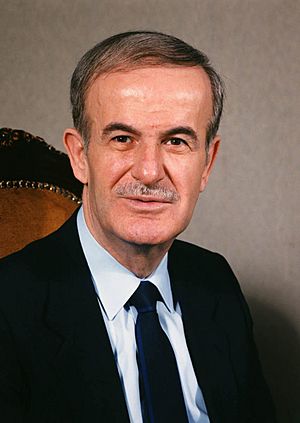
Assad c. 1987
|
|
| 18th President of Syria | |
| In office 12 March 1971 – 10 June 2000 |
|
| Prime Minister | Himself Abdul Rahman Khleifawi Mahmoud al-Ayyubi Abdul Rahman Khleifawi Muhammad Ali al-Halabi Abdul Rauf al-Kasm Mahmoud Zuabi Muhammad Mustafa Mero |
| Vice President | Mahmoud al-Ayyubi (1971–1976) Rifaat al-Assad (1984–1998) Abdul Halim Khaddam (1984–2000) Zuhair Masharqa (1984–2000) |
| Preceded by | Ahmad al-Khatib (acting) |
| Succeeded by | Abdul Halim Khaddam (acting) Bashar al-Assad |
| Prime Minister of Syria | |
| In office 21 November 1970 – 3 April 1971 |
|
| President | Ahmad al-Khatib Himself |
| Preceded by | Nureddin al-Atassi |
| Succeeded by | Abdul Rahman Khleifawi |
| Regional Secretary of the Regional Command of the Syrian Regional Branch | |
| In office 18 November 1970 – 10 June 2000 |
|
| Deputy | Mohamad Jaber Bajbouj Zuhair Masharqa Sulayman Qaddah |
| Preceded by | Nureddin al-Atassi |
| Succeeded by | Bashar al-Assad |
| Secretary General of the National Command of the Arab Socialist Ba'ath Party | |
| In office 12 September 1971 – 10 June 2000 |
|
| Deputy | Abdullah al-Ahmar |
| Preceded by | Nureddin al-Atassi |
| Succeeded by | Abdullah al-Ahmar |
| 7th Minister of Defense | |
| In office 23 February 1966 – 22 March 1972 |
|
| President | Nureddin al-Atassi Ahmad al-Khatib Himself |
| Prime Minister | Yusuf Zuaiyin Nureddin al-Atassi Himself Abdul Rahman Kleifawi |
| Preceded by | Muhammad Umran |
| Succeeded by | Mustafa Tlass |
| Member of the Regional Command of the Syrian Regional Branch | |
| In office 27 March 1966 – 10 June 2000 |
|
| In office 5 September 1963 – 4 April 1965 |
|
| Personal details | |
| Born | 6 October 1930 Qardaha, Alawite State, Mandate for Syria and the Lebanon |
| Died | 10 June 2000 (aged 69) Damascus, Syria |
| Cause of death | Heart attack |
| Resting place | Qardaha, Syria |
| Political party | Ba'ath Party (Syrian faction) (since 1966) |
| Other political affiliations |
Arab Ba'ath Party (1946–1947) Ba'ath Party (1947–1966) |
| Spouse |
Anisa Makhlouf
(m. 1957) |
| Relations |
|
| Children | |
| Parents |
|
| Alma mater | Homs Military Academy |
| Signature | |
| Military service | |
| Allegiance | |
| Branch/service | Syrian Air Force Syrian Armed Forces |
| Years of service | 1952–2000 |
| Rank | |
| Commands | Syrian Air Force Syrian Armed Forces |
| Battles/wars | Six-Day War (1967) War of Attrition (1967–1970) Black September (1970–1971) Yom Kippur War (1973) |
Hafez al-Assad (born October 6, 1930 – died June 10, 2000) was a Syrian leader and military officer. He was the President of Syria from 1971 until his death in 2000. Before becoming president, he was the Prime Minister of Syria from 1970 to 1971.
Assad played a big part in the 1963 coup d'état (a sudden takeover of government) that brought the Ba'ath Party to power in Syria. He became the commander of the Syrian Air Force. In 1966, he was part of another coup and became the defense minister. Four years later, Assad led a third coup, taking control of Syria himself.
When he became leader, Assad changed how the government worked. He focused on a planned economy that allowed some private businesses. He also improved Syria's relationships with other countries, even those his predecessor didn't like. Assad worked closely with the Soviet Union during the Cold War to get support against Israel. He wanted Syria to be seen as a protector of the Palestinians.
Assad changed the government to give more power to the presidency. He also made sure that people from his own group, the Alawites, held important positions in the military and security. A "cult of personality" was built around Assad and his family, meaning people were encouraged to admire and respect him greatly. In 1976, Assad sent the Syrian army into Lebanon, where they stayed until 2005. During his time as leader, he also faced an uprising by an Islamist group, which was put down with strong force in 1982.
Assad wanted his son, Bassel al-Assad, to take over after him. But Bassel died in a car accident in 1994. So, Assad chose his younger son, Bashar al-Assad, who had little political experience at the time. Hafez al-Assad died in 2000, and Bashar became the new president.
Contents
Early Life and Education
Family Background
Hafez al-Assad was born on October 6, 1930, in Qardaha, a village in Syria. His family belonged to the Alawites, a religious group. His father, Ali Sulayman al-Assad, was a respected local figure. People called his father "al-Assad," meaning "the lion," because of his achievements. In 1927, this nickname became their family name.
School and Early Politics
Hafez was the first in his family to go to high school. He started school at age nine in Latakia, a city where most people were Sunni Muslims. As an Alawite, he sometimes faced prejudice. He was a very good student and won several awards.
To fit in, Assad joined political groups that welcomed Alawites. In 1946, he joined the Ba'ath Party. This party believed in Pan-Arabism, which means uniting all Arab countries, and Arab socialism, which focuses on social equality. Assad was good at organizing and recruiting new members for the party. He met many people in school who would later work for him when he became president.
Air Force Career

After high school, Assad wanted to be a doctor, but his family couldn't afford it. So, in 1950, he joined the Syrian Armed Forces. He went to military academy in Homs and then flying school in Aleppo. He graduated in 1955 and became a lieutenant in the Syrian Air Force. He was a top student and won a trophy for being the best aviator.
In 1957, Assad married Anisa Makhlouf. He also went to the Soviet Union for ten months to train on new MiG-17 planes.
In 1958, Syria and Egypt joined together to form the United Arab Republic (UAR). All Syrian political parties were dissolved. Assad stayed in the army and quickly moved up in rank. He was transferred to Egypt and continued his military training there.
Road to Power
Before the 1963 Coup
Assad saw his military career as a way to get into politics. When the UAR was formed, the Ba'ath Party was dissolved. Assad and other young officers secretly formed a "Military Committee" to bring the party back to power in Syria.
After Syria left the UAR in 1961, Assad and other Ba'athist officers were removed from the military. He was given a small office job. However, the Ba'ath Party was re-established, and the Military Committee planned to take power by force.
The 1963 Coup
In March 1963, the Ba'ath Party successfully took over the government in Iraq. This encouraged the Military Committee to act quickly in Syria. Assad helped plan the coup. He led a small group to capture the Dumayr airbase near Damascus. His group was the only one that faced resistance, but they managed to take the base.
Early Ba'ath Party Rule
Ba'ath Party Leadership (1963–1966)
After the 1963 coup, Assad was elected to the Syrian Regional Command, a top decision-making body. This was his first step into national politics. He worked to make the Syrian military loyal to the Ba'ath Party. He appointed officers he trusted to important jobs and made sure soldiers were taught about Ba'ath ideas.
By the end of 1964, Assad was in charge of the Syrian Air Force. He gave special benefits to Air Force officers and built a strong intelligence network within the Air Force.
Power Struggles and the 1966 Coup
In 1964, there was a riot in Hama. Assad voted to use force to stop it. This caused a split within the Military Committee. Assad sided with Salah Jadid, who wanted a strong one-party government.
In 1966, the Military Committee, led by Jadid, overthrew the older leaders of the Ba'ath Party. This event caused a lasting split in the Ba'ath movement, creating two main branches: one in Iraq and one in Syria.
Jadid's Leadership (1966–1970)
After the 1966 coup, Assad became the Minister of Defense. This was his first government job. At this time, Jadid was the main leader of Syria. Jadid focused on civilian issues and gave Assad control of the military, not seeing him as a threat.
In late 1966, there was another attempt to overthrow Jadid's government. Assad quickly sent troops to stop it, earning Jadid's trust. After this, Assad and Jadid removed many officers from the military who were not loyal to them. This made the military weaker.
Taking Control of Syria
Syria lost the Golan Heights to Israel in the Six-Day War in 1967. This led to big arguments among Syria's leaders. The civilian leaders blamed the military, and the military blamed the civilian leaders. Assad, who was Minister of Defense, was almost voted out of his position.
The war was a turning point for Assad. He began to build his own network of support in the military, promoting friends and family members to high positions. Assad believed that Syria's defeat was Jadid's fault. He thought Jadid's focus on "people's war" and class struggle had weakened Syria. Assad wanted to focus on foreign policy and dealing with Israel.
The conflict between Assad and Jadid grew. Assad wanted to make it easier for people to join the Ba'ath Party, while Jadid was worried about opportunists joining. Assad also wanted to improve relations with Iraq to form a front against Israel.
By 1968, Assad had strong control over the army, but Jadid still controlled the party. The power struggle became very clear. In February 1969, the conflict turned violent between their supporters. Assad's brother, Rifaat al-Assad, believed that Assad's life was in danger. Assad's loyal troops moved into Damascus. After this, Assad was in control, but he waited to take full power. Jadid still ruled, but Assad influenced him to change some policies.
The 1970 Coup
Assad began planning to take full power after Syria's military failed to help in a conflict in Jordan. Although Assad had been in control of Syrian politics since 1969, Jadid still held the official positions of power.
At a party meeting in October 1970, Assad was criticized by Jadid's supporters. But Assad had already ordered his loyal troops to surround the building where the meeting was held. On November 12, 1970, Assad ordered the arrest of Jadid and other top government members. The takeover was peaceful. Assad became the new leader of Syria.
President of Syria
Strengthening Power
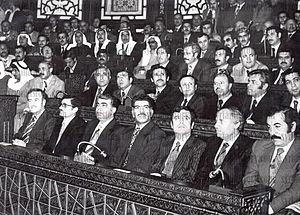
When Assad took power, many Syrians were relieved because the previous government was unpopular. He tried to unite the country. He visited villages and listened to people's complaints. He lowered prices for basic foods, which made him popular. He also eased travel and trade rules with Lebanon and encouraged private businesses.
Assad made the presidency a very powerful position. He became the main decision-maker, and his authority grew stronger over time. He was seen as the main symbol of the government. While he worked with others, he always had the final say.
Sectarianism in Government
Assad increased the power of Alawites in the security and intelligence parts of the government. Many of the top figures in these areas were Alawites and had family connections to Assad. For example, his brother Rifaat controlled important military units, and his son-in-law was a commander of the Presidential Guard.
While some Sunni Muslims held important positions, their power came from Assad. They could not make decisions without his approval or the approval of the Alawite-controlled security system. This created an Alawite elite in the government.
Islamist Uprising
During the 1970s, Assad's economic policies led to some people in the government using their positions for personal gain. This caused corruption and made some people, especially Sunni Muslims, unhappy with the government. This unhappiness helped an Islamist group, the Muslim Brotherhood of Syria, grow stronger.
The uprising began in the mid-1970s with attacks on Alawite officials. The conflict became more serious, with fighting in cities like Aleppo and Hama. The government responded with strong force. In 1980, membership in the Muslim Brotherhood became a crime punishable by death.
The conflict ended in February 1982 with a major government action in Hama. The city was heavily damaged, and many people died. After the uprising, Syria became even more controlled by the government, and Assad's power as leader grew stronger.
Succession Challenges
In 1983, Assad had a heart attack, which led to a crisis over who would take over. His brother, Rifaat al-Assad, tried to become president. Rifaat was known for being corrupt and his military units were not popular. Most top officials did not support him.
Rifaat's supporters even replaced posters of Hafez al-Assad in Damascus with posters of Rifaat. But Assad's health improved, and he removed Rifaat's supporters from power. Rifaat was eventually sent into exile, though he was allowed to return later without a political role.
Planning for the Future

Assad's first choice to succeed him was his eldest son, Bassel. Bassel was given a larger role in the government. However, Bassel died in a car accident in 1994. After this, Assad chose his younger son, Bashar al-Assad, to be his successor. Bashar had no political experience at the time.
Bashar joined the military academy and was quickly promoted. Assad also appointed new Alawite security officers who were loyal to Bashar. Some older officials who might not support Bashar were removed from their positions.
By the late 1990s, Assad's health was getting worse. He had difficulty staying focused and seemed tired. His daughter, Bushra, reportedly took on many of his daily tasks.
Death and Legacy
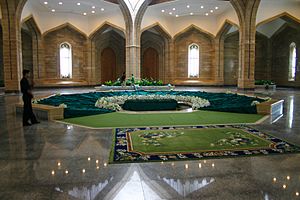
On June 10, 2000, Hafez al-Assad died of a heart attack at the age of 69. He was on the phone with the Lebanese prime minister at the time. Syria declared 40 days of mourning, and other Arab countries also announced days of mourning. His funeral was held three days later. Assad is buried with his son, Bassel, in a special tomb in his hometown of Qardaha.
Economic Changes
Assad called his changes to Syria's economy a "corrective movement." He tried to modernize farming and factories. One of his biggest achievements was building the Tabqa Dam on the Euphrates River in 1974. This dam created Lake Assad, which helped irrigate farmland, provide electricity, and encourage new industries. Many farmers and workers saw their incomes increase and received better social services.
However, by 1977, it was clear that many economic problems remained. There was inefficiency, corruption, and a lack of good education. Syria's involvement in the Lebanese Civil War also cost a lot of money, leading to more corruption and a black market.
In the early 1980s, Syria's economy got worse. There were severe food shortages and high prices. Smuggling goods from Lebanon became common. Assad's government tried to stop smuggling, but it was difficult because some high-ranking officials were involved.
The Syrian economy improved in the early 1990s. Exports increased, and oil exports grew. In 1991, Assad's government made it easier for private businesses to invest in Syria. However, Syria did not privatize state-owned companies because of the Ba'ath Party's socialist beliefs.
By the mid-1990s, Syria's economy slowed down again. Growth was very low, and a severe drought in 1999 hurt crop yields. Assad's government tried to help farmers, but it was not enough. Syria also struggled to meet the demands of the European Union to open its economy and make reforms.
Foreign Policy
Yom Kippur War
Assad believed that Israel had won the Six-Day War unfairly. After he came to power, his main goal was to get back the Arab land lost in that war. He thought that the only way to make Israel negotiate was through war.
Assad sought allies and weapons for a war against Israel. He visited the Soviet Union, which agreed to send arms to Syria. He also made an agreement with Egyptian President Anwar Sadat to plan a joint attack. They appointed an Egyptian general to lead both armies.
The war began on October 6, 1973. Egyptian forces attacked through the Sinai Peninsula, and Syrian forces attacked the Golan Heights. Syrian forces faced tough fighting but broke through Israeli defenses. The Syrian army's early successes were due to its well-trained officers and advanced Soviet weapons.
However, Egypt stopped its attack after a few days, leaving Syria to fight Israel alone. The Israelis then focused their full force on the Syrian military. By October 9, the Syrians were retreating. By October 13, the war was lost for Syria. But unlike the Six-Day War, the Syrian army was not completely defeated, which earned Assad respect.
Egypt later called for a ceasefire without telling Assad. Assad was annoyed because Sadat's decision affected both countries. On October 23, Syria also accepted the ceasefire.
Lebanese Civil War
Syria got involved in the Lebanese Civil War in 1976. The war started in 1975. Syria first tried to help solve the conflict. When that didn't work, Assad sent Syrian troops into Lebanon.
Assad did not want a victory for either the leftist or rightist groups in Lebanon. He wanted a balanced solution. In May 1976, Syria began a full military intervention in Lebanon. The Syrian troop presence slowly grew to 30,000 soldiers. Syria received approval for this from the United States and Israel, who wanted help defeating Palestinian forces in Lebanon.
Assad's actions angered many Arab countries. The sight of Syria fighting Palestinian groups brought criticism. The Arab League stepped in to help, creating the Arab Deterrent Force (ADF) for peacekeeping. Most of the ADF troops were Syrian. By 1977, the main part of the Lebanese Civil War had ended.
Assad used various methods to keep control over Lebanon. Some Lebanese leaders who resisted his influence were assassinated. Assad also worked to prevent agreements between Jordan and the Palestinians.
Foreign Honours
Images for kids
-
Assad greeting Richard Nixon on his arrival at Damascus Airport, 15 July 1974
-
Assad (center) and Nureddin al-Atassi (left) meeting with Egyptian President Gamal Abdel Nasser, 1969
See also
 In Spanish: Háfez al-Ásad para niños
In Spanish: Háfez al-Ásad para niños


